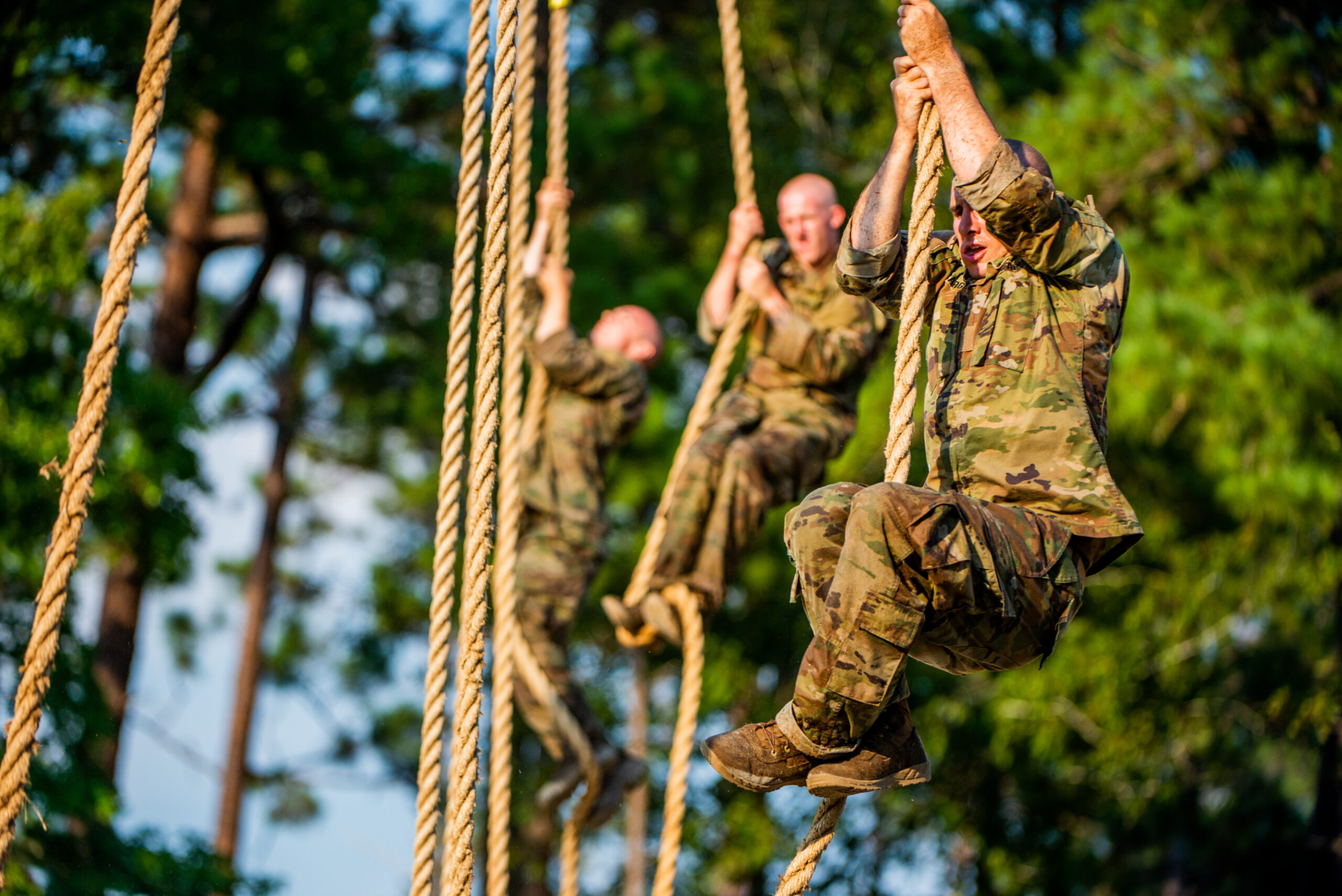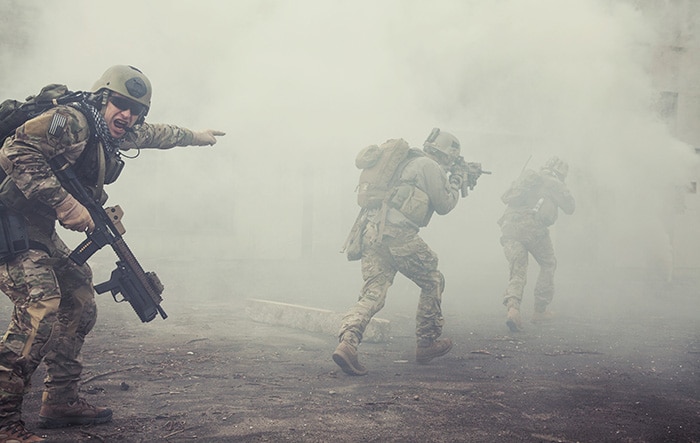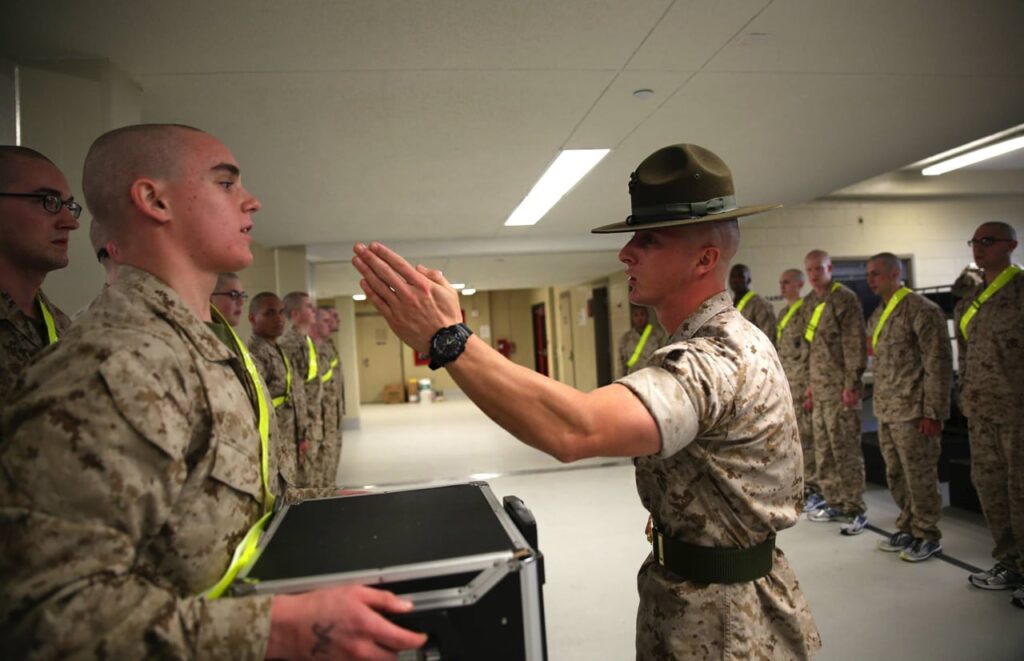
- The App
- Sandboxx News
- Resources
Learn
- Company
About
Become a Partner
Support
- The App
- Sandboxx News
- Resources
Learn
- Company
About
Become a Partner
Support

Every Special Operations group has its own mythos surrounding it. People associate the United States Army’s 75th Ranger Regiment with complex raids, smashing and grabbing Taliban commanders, or seizing airfields under fire. Like any other Special Operations group, this mythos certainly includes a grueling selection process — endless pushups, nights out in the mud and rain, countless burned calories, and the sort of suffering that pushes your expectations of the human spirit.
There is a whole lot of talk about these things, but what steps are involved in becoming an enlisted Ranger? What will their timeline look like? How does one walk off the street and onto a helicopter bound for enemy contact?

First of all, you have to join the Army, and that means approaching a recruiter. However, it’s important to know: despite their confidence, a lot of recruiters aren’t actually aware of the process required to become a Ranger, and any information should be double-checked (ideally with someone already in the Regiment).
The common misconception is that there is no such thing as a Ranger contract, ensuring a place within the Regiment as long as you pass all required courses. This is false. Ranger contracts exist, though you might have to wait to get one. If your recruiter tells you otherwise, it may be wise to find a new recruiter (some are very good, others not so much).

Every enlisted man and woman in the Army has a job — it’s called their MOS (Military Occupational Specialty). When most people think of Rangers, they think of the infantrymen — the folks kicking or blowing up doors, clearing rooms, fighting up ridge lines — the works. For the purposes of this article, we will assume this is what the candidate wants to do. There are other incredible combat jobs within the 75th Ranger Regiment, like the medics or the forward operators; there are support positions too, like supply or NBC, but their routes are all slightly different. However, the overall path looks more or less the same.
The typical Ranger contract is called an 11X. This means the Army will decide whether or not you will be a 11B (infantryman) or an 11C (mortarman) — the candidate does not get to choose this. It also means they will get a slot in the Ranger Regiment as long as they pass Basic Training, Airborne School, and RASP. We’ll get into what those are next.
Remember, you still have agency here. You don’t belong to the Army until you’ve actually signed up and left for it. Work with your recruiter to find the best option for you, and don’t rush into anything.

That’s when you ship out. There’s a short, miserable period of shots and paperwork and physical assessments, but soon you’ll find yourself in basic training. For most people in the military, you go to basic training (often known as boot camp), and then you go to your job training (MOS). For a number of reasons, the Army combined the MOS school with basic training for all infantry candidates — this program is called OSUT (One Station Unit Training).
Infantry OSUT is now 22 weeks long (and you can still call it boot camp or basic training if you’d like), and it’s there you’ll learn all the things you think about when you think of the military — what rank is, how it works, how to handle basic weaponry, how to march, uniform and hair standards — it’s like drinking from a fire hose, but it’s all very doable. On top of that, you get the yelling and screaming and ‘smoking.’ Getting smoked is an endearing term for doing pushups, carrying your buddy, doing pointless drills with sandbags, and other physical exercises meant to punish and/or teach.
Attrition rates: low. Most people who qualify make it through the Army’s OSUT.

Upon completion of Infantry OSUT, the candidate will need to qualify for Airborne school. You can find the qualifications here.
In Airborne School, the would-be Ranger is not under nearly as much restriction as he was in basic training. He can contact his family members and have fun on the weekends, but he’s still in an intensive school aimed at teaching him something pretty dangerous — jumping out of airplanes.
This is static-line jumping, where the chute’s ripcord is essentially attached the airplane itself — it’s much less technical than free-falling. Some might even argue that three weeks for this school is a little excessive.
Attrition rates: moderate to low. The physical standards get a few people right out the gate (pull ups being a big one), but most people attempting have had time to prepare. Some people fail due to technical portions in the first few weeks, and a few more get injured during the jumps. Still, most Ranger-candidates will have no problem passing Airborne school.

By now, you’ve gone through basic and Airborne. Ranger Assessment and Selection Program (RASP) is the big beast looming ahead, and many candidates drop out right when that fear and anticipation starts to become a reality. Basic training sucked, Airborne was an extra push, and they just want to get to a unit and start with their work. After all, being in an airborne unit is something to be proud of, they would like to see their families, and the idea that the hardest by far is yet to come sounds pretty terrible.
RASP is the selection process required to enter the 75th Ranger Regiment. It’s painful and will push you to your limits. It’s also 2 months long.
RASP Hold is simply the group waiting for the next RASP class to start. I only include this because, on some occasions, this can take quite a while. Most people push through in a week or two, but if you happen to finish Airborne right before a holiday, you might have to wait until the season is through before you can make an attempt at RASP.
Some people are in RASP Hold because they failed or recycled a phase in RASP. Those people can be valuable resources for learning what’s to come. With that said, if they failed, they might paint it as an unwinnable scenario. This is simply not true — if you’ve made it here, physically speaking, it’s pretty likely you are able to pass. Listening to naysayers can be disheartening, and it’s helpful to know that RASP Hold can be chock-full of naysayers from time to time.

A whole lot goes on in RASP. Logistically speaking, the first month (Phase I) is comprised of a few hellish weeks where the cadre try and get their prospects to quit. This is where most people fall out, the vast majority of them quitting by choice. This culminates in Cole Range, a few days in the woods of extreme pain and suffering. Cole Range is where most people quit, get injured, or fall to the wayside and fail to meet the standard.
Phase II (the second month) is where they teach you some extremely beneficial fundamentals of being a Ranger that you didn’t get from OSUT. More advanced shooting courses, driving, fast-roping, explosive breaching — this way when you get to the 75th Ranger Regiment, you won’t be quite so far behind everyone.

Note: If you’ve heard of RIP (Ranger Indoctrination Program), you’ve probably heard all sorts of ‘back when it was hard’ type stories. All you really need to know is that RIP is just an older form of RASP, back before it had Phase II.
If you’ve made it here, the primary things to remember are: don’t quit, take care of your buddies (and they will take care of you), take the rules seriously, and push yourself every day. You’ll hear a whole bunch of reasons why someone didn’t make it — many are suspect (‘they forced me to quit,’ ‘didn’t want to be there anyway, etc.), but while you’re in RASP the only concern is making it.
You have to be smart and strong to make it through RASP, but many of the smartest and strongest don’t make it. A strong conviction to never quit is also an absolute requirement here. With that said, it really isn’t for everyone, and that’s okay.
If you pass, you’re assigned to somewhere within the 75th Ranger Regiment. You are now an Army Ranger, even though you haven’t gone to Ranger School (we’ll get to that later).
Attrition Rate: This varies. Sometimes it’s extremely high (approximately 80 starting and 25 finishing), sometimes it’s much lower (3/4 of students making it). Some say it depends on changes in the program, some say it’s dependent on the needs of the Regiment — none of this matters to the candidate. Just don’t quit.

There are three Ranger Battalions, known colloquially as ‘batts.’ 1st Batt is in Savannah, GA, 2nd Batt is in Ft. Lewis, Washington, and 3rd Batt is in Columbus, GA. Functionally, as far as the enlisted Ranger infantryman is concerned, there is no difference between these battalions other than location.
Again, you’re a Ranger now. If you were an infantryman, you’re probably going to get assigned to a company in your Battalion and you’ll start doing your regular, yearly training.
However, you haven’t been to Ranger School yet, and your suffering is far from over. Here is an important distinction: RASP is where you get selected to be a Ranger. Ranger School is an elite Army school that has little to do with the Regiment itself, logistically speaking (though it is a huge part of the culture).
Usually after your first slew of training and your first deployment, they will send you off to Ranger School. That’s typically a bit less than a year from arriving to the Regiment.

Think of Ranger School as a rite of passage to really sink your teeth into your career in Special Operations, and the first step in becoming a leader within the Regiment. RASP is where you get your Ranger scroll; Ranger School is where you get your Ranger Tab. The prior is a unit where you live and work; the latter is basically a badge of honor (so to speak).
Until then you’re the new guy in Batt. Life can be a bit strenuous when you’re an ‘untabbed’ Ranger in the Regiment, to say the least, but that stress has driven many-a-young Ranger to pass school with flying colors.

Ranger School is another grueling course — it’s 61 days long and broken up into three phases. They are Benning Phase, Mountain Phase, and Florida Phase, and even if you don’t quit, it’s very possible to fail any of these phases. If that happens, you might get a chance to “recycle,” or start that whole phase over again. That means this course can possibly take a good deal longer than 61 days, depending on what happens.
If you don’t pass Ranger School, you are going to have a very difficult time in the Regiment. They may opt to send you for another try, or you may get the boot entirely and — after all your hard work — send you back to the regular Army.
Or you can pass.
Attrition Rate: This can vary as well, fluctuating from 1/3 to 1/2 passing, however there have been classes when very few have passed at all.
Upon finishing Ranger School, one can really settle into their career in the 75th Ranger Regiment. They are generally put into leadership positions, and they have more flexibility as to how they want to move forward. Some stay in regular infantry positions and become Team Leaders, Squad Leaders, and eventually Platoon Sergeants. Others flex to specialty positions, like becoming a sniper or a K9 handler.

A Ranger’s life generally goes back and forth between deployments and ‘training cycles,’ where they train a series of culminating events over and over to hone their skills. However, the daily, weekly, and monthly lives of Rangers is another story.
These are the basics to becoming a U.S. Army Ranger. It’s a long and arduous journey, but the vast majority of Rangers will tell you that it was worth it. The rapid deployments, the intensive training cycles, other military schools, the selection process to get there in the first place — it boils groups down to some of the finest men in the U.S. Armed Forces.
To work among those men is often one of the greatest honors of many Rangers’ lives.




